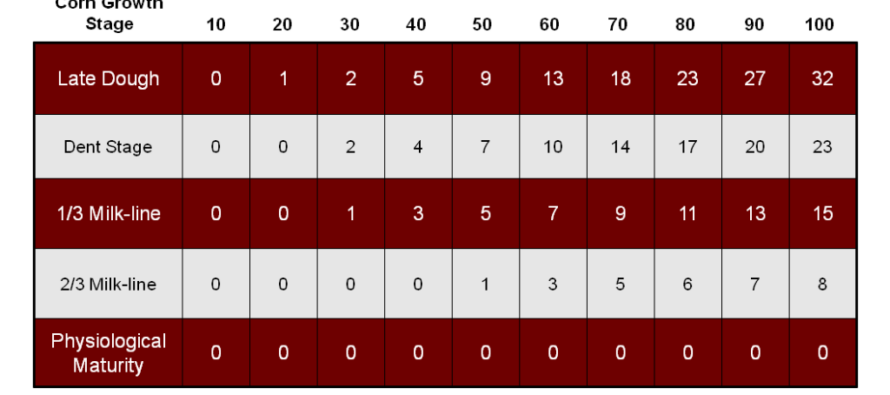Vulnerability of Corn to Late-Season Issues?

It is getting that time of year where many begin contemplating whether or not their corn crop is still vulnerable to various late-season issues or stress. The potential yield loss resulting from various issues depends greatly on the maturity of the corn crop and the extent and severity of the problem.
 Corn yield loss can occur anytime until physiological maturity, but is far more vulnerable to stress at early reproductive stages and becomes increasingly less sensitive as it matures. Corn is better able to compensate for shortcomings during late vegetative stages because it will more readily reallocate energy and resources from vegetative parts to help fill grain, which it is much less able to do during early reproductive stages. This, depletion of vegetative resources, in turn often causes leaves to die or senesce prematurely and may potentially reduce stalk integrity. Of course, once plants attain physiological maturity, plant stress has no effect on grain yield.
Corn yield loss can occur anytime until physiological maturity, but is far more vulnerable to stress at early reproductive stages and becomes increasingly less sensitive as it matures. Corn is better able to compensate for shortcomings during late vegetative stages because it will more readily reallocate energy and resources from vegetative parts to help fill grain, which it is much less able to do during early reproductive stages. This, depletion of vegetative resources, in turn often causes leaves to die or senesce prematurely and may potentially reduce stalk integrity. Of course, once plants attain physiological maturity, plant stress has no effect on grain yield.
The 2014 Mississippi corn crop is currently about four days later than normal, based upon weather data collected at Stoneville, MS, compared to historical averages. Furthermore, corn maturity varies widely depending upon planting date and geography, but as a general rule, a lot of the north MS crop is approaching the full dent stage. Later corn is certainly more vulnerable.
 We are presenting this chart in order to help assess potential yield loss and risk associated with late-season issues which may defoliate corn during late reproductive stages. It was adapted from the National Crop Insurance Service’s “Corn Loss Instructions” (1984). It was originally developed for estimating yield loss resulting from hail damage, but may have utility for other issues which may defoliate corn as well, such as a disease like Southern rust or a premature “harvest aid” herbicide application. Of course, if you use this for estimating potential yield loss associated with Southern rust infection, you are working with a moving target, whose development and potential for subsequent defoliation may vary considerably depending upon environmental conditions and potentially hybrid susceptibility. Thus, frequent field scouting is imperative to making prudent management decisions.
We are presenting this chart in order to help assess potential yield loss and risk associated with late-season issues which may defoliate corn during late reproductive stages. It was adapted from the National Crop Insurance Service’s “Corn Loss Instructions” (1984). It was originally developed for estimating yield loss resulting from hail damage, but may have utility for other issues which may defoliate corn as well, such as a disease like Southern rust or a premature “harvest aid” herbicide application. Of course, if you use this for estimating potential yield loss associated with Southern rust infection, you are working with a moving target, whose development and potential for subsequent defoliation may vary considerably depending upon environmental conditions and potentially hybrid susceptibility. Thus, frequent field scouting is imperative to making prudent management decisions.
For more information see: http://wp.me/p1jA50-1ae




Let me tell You a sad story ! There are no comments yet, but You can be first one to comment this article.
Write a comment